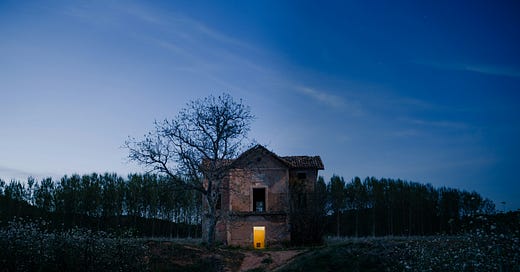Carissa Orlando’s debut novel, The September House, is like a comfy chair. I immediately sunk into it, knowing from the very first page that I’d love it. (It seems a lot of people feel similarly, since there was a long queue for it at the library.) Orlando brilliantly takes the family-moves-into-a-haunted-house trope, à la The Amityville Horror, but asks, “What if they stayed?”
The story’s protagonist, Margaret, has learned to coexist with the “pranksters,” as she calls them, haunting her home. The month of September is the worst, as the walls bleed and scream, and the ghosts—except malevolent Master Vale, trapped in the basement—pop up all over the place. And then there are the birds, who regularly fly into the sides of the house, dying instantly.
This is a tired trope of the horror genre, appearing in endless stories. I was prepared to sigh and shrug off the cliché killing of animals, but then I reached this line:
“I was never quite sure about the birds.”
At this point, Margaret is thinking about why only the spirits most closely associated with Master Vale seem soothed by her priest’s regular exorcisms. But she has no idea why the birds act the way they do. This admission almost feels like Orlando herself is acknowledging that she doesn’t know why the birds do this. (Unlike the pranksters, the birds circle around the plot rather than playing an active role in it.)
Since we never get an explanation, I’ve come up with some theories.
Theory 1: Standard plot device
As a practicing fiction writer myself, I’ve learned that everything you write must have a purpose in your story. With all the other supernatural occurrences in Margaret’s home having an explanation, the mystery of the birds (and, to a lesser extent, the flies, but I’m not getting into that today) remains unresolved.
While animal killings often feel like a lazy plot device, I appreciate that Orlando at least did something a little different by ramping up the body count. (Hey, if humans can be brutally murdered, why not animals?) Though I do wonder why only birds seem to be affected. Why not snails, snakes, raccoons, cats, squirrels, etc?
Because I love this book so much, I’m hesitant to entirely write off the birds as merely an overdone cliché. Which leads me to…
Theory 2: They’re already dead
Perhaps the birds Margaret sees have already died and, like the pranksters, are stuck on the property. Since all the ghosts retain their bodily injuries in the afterlife—wandering about with split heads and missing limbs—it would make sense that Margaret always finds the birds on the ground with snapped necks. (If memory serves, she never actually sees the birds fly into the house, though she does hear them.) Plus, the ghosts appear just as solid as livings, supporting this theory.
But there are a few glaring flaws:
Margaret experiences a ghost’s moment of death when she touches them, but she doesn’t feel her spine crack each time she picks up a bird.
Ants crawl over the dead bird bodies, indicating that the decomposition process has begun. (Unless the ants are ghosts, too. That’d be cool; I’d read a book about ghost ants.)
She usually burns the corpses, and she never mentions them squawking as their spirits flee the flames.
Though the ghosts tend to hang out where they died, none reenact their deaths, so it would be incongruous for only the birds to be stuck in that sort of loop in the afterlife.
My strongest piece of evidence in favor of this theory is that after defeating Master Vale, Margaret sees one of the ghosts—now happy and healed of her ghastly injuries—up on the roof with a bird sitting on her shoulder, the pair whistling a tune. It’s possible that birds can see ghosts better than humans (most of whom can’t see spirits at first), but I’m guessing this is more symbolic than anything, a sign that things are well again.
I have to say I was really excited about this theory, but it seems unlikely that the birds are ghosts. Of course, it’s entirely possible we’re dealing with some speciesism here and that nonhuman animals unintentionally follow different rules in the afterlife. And actually, speciesism is pretty integral to…
Theory 3: The house’s spiritual energy draws them there
With so many bird deaths on the property—far exceeding the number of human deaths—it seems inevitable that there would be ghost birds flitting about. But because Margaret never interacts with a ghost bird, I’m led to the conclusion that the house’s negative energy summons the birds, enticing them to end their lives. Orlando, in fact, supports this theory with her own words: Master Vale influences new residents to kill each other and themselves, ballooning his body count and holding more spirits hostage. However, it takes time for him to infect the minds of his tenants. None of the humans who enter the property immediately bash their heads against the nearest blunt object. For the birds to so quickly fall under his influence seems like a stretch too far—unless animals have a lower threshold for spiritual resistance.
There’s no clear or satisfying answer, unfortunately, but I think the best theory is a combination of all three.
On my mind: Apartment 7A
Rosemary’s Baby is one of those eternal stories, a tale just as prescient today as it was 60 years ago. And Apartment 7A is the prequel I never knew I needed. Since it only just came out, I won’t spoil anything, but I find it interesting how often we learn which characters are good or bad by whether or not they’re vegetarian.
(Also, I just have to add that that was the most bedazzled version of the devil I’ve ever seen, and I know he’s literally evil incarnate, but I kind of love his style?)
Be sure to tune in next week for my breakdown of The Witch!




